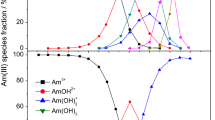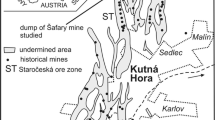Abstract
Interactions of components of the multibarrier safety system of an underground repository environment are important factors for safety assessments. Na–Al–P glass is the major high level waste (HLW) matrix in Russia. Degradation of HLW glass causes an increase of phosphate concentration in water that influences on radionuclides speciation. Americium is important in HLW. In the presence of phosphate in synthetic groundwater almost half of the americium present is in colloidal matter and its sorption onto clay is slightly decreased relative to the absence of phosphate. The presence of phosphates in the system of synthetic groundwater—clay during sorption experiments significantly affected on the solid-phase speciation and led to an increase in the proportion of strongly bound americium.


Similar content being viewed by others
References
Rybalchenko AI, Zubkov AA, Ponisov AV, Mironov VV, Turkovsky AD (2011) Final isolation of liquid radwaste in deep reservoir beds. Nucl Environ Saf 1:72–77
Ochkin AV (2014) Reprocessing issues of spent nuclear fuel from the modern nuclear reactors. Theor Basis Chem Technol. https://doi.org/10.7868/s0040357114010084 (in Russian)
Salvatores M, Palmiotti G (2011) Radioactive waste partitioning and transmutation within advanced fuel cycles: achievements and challenges. Progr Part Nucl Phys 66:144–166
González-Romero EM (2011) Impact of partitioning and transmutation on the high level waste management. Nucl Eng Des 241:3436–3444
Zakari-Issoufou AA, Doligez X, Somaini A, Hoarau Q, David S, Bouneau S, Courtin F, Leniau B, Thiollière N, Mouginot B, Bidaud A, Capellan N, Meplan O, Nuttin A, Sogbadji R (2017) Americium mono-recycling in PWR: a step towards transmutation. Ann Nucl Eng 102:220–230
Khaperskaya AV (2012) Problems with spent fuel management in Russia and their prospective solution. Nucl Environ Saf 3:50–56
Laverov NP, Yudintsev SV, Kochkin BT, Malkovsky VI (2016) The Russian strategy of using crystalline rock as a repository for nuclear waste. Elements 12:253–256
Wang J, Chen L, Su R, Zhao X (2018) The Beishan underground research laboratory for geological disposal of high-level radioactive waste in China: planning, site selection, site characterization and in situ tests. J Rock Mech Geotech Eng 10(3):411–435
Andersson P, Stark K, Xu S, Norden M, Dverstorp B (2017) The Swedish radiological environmental protection regulations applied in a review of a license application for a geological repository for spent nuclear fuel. J Environ Radioact 178–179:439–445
Vira J (2017) In: Apted MJ, Ahn J (eds) Geological repository systems for safe disposal of spent nuclear fuels and radioactive waste, 2nd edn. Woodhead Publishing, Cambridge
Belousov PE, Krupskaya VV, Zakusin SV, Zhigarev VV (2017) Bentonite clays from 10th Khutor deposite: features of genesis, composition and adsorption properties. RUDN J Eng Res. https://doi.org/10.22363/2312-8143-2017-18-1-135-143 (in Russian)
Batorshin GS (2011) Management strategy for liquid radioactive waste at the Mayak plant. Nucl Environ Saf 1:88–93
Kooyman T, Buiron L, Rimpault G (2018) A comparison of curium, neptunium and americium transmutation feasibility. Ann Nucl Energy 112:748–758
Konevnik YuV, Zakharova EV, Martynov KV, Andryushchenko ND, Proshin IM (2017) Influence of temperature on the sorption properties of rocks from the Nizhnekansky Massif. Radiochemistry 59(3):313–319
Pervukhina AM (2018) Formation of primary radiocolloids in leaching of sodium–alumophosphate glass matrix of radioactive wastes. Geoekologiya Inzhenernaya geologiya Gidrogeologiya Geokriologiya https://doi.org/10.7868/s0869780318030080 (in Russian)
Martynov KV, Konstantinova LI, Konevnik YuV, Zakharova EV (2014) Simulation of aluminophosphate glass leaching by underground waters after their interaction with clay engineering barriers. Rad Saf Problems 2:43–50
Martynov KV, Konstantinova LI, Zakharova EV (2015) Temperature effects on the leaching of simulated phosphate glass containing radioactive waste simulants. Rad Saf Problems 4:10–21
Silva RJ, Bidoglio G, Rand MH, Robouch PB, Wanner H, Puigdomenech I (2004) Chemical thermodynamics of americium. Elsevier, Amsterdam
Reiller PE, Vercouter T, Duro L, Ekberg C (2012) Thermodynamic data provided through the FUNMIG project: analyses and prospective. App Geochem 27(2):414–426
Baghdadi S, Bouvier-Capely C, Ritt A, Peroux A, Fevrier L, Rebiere F, Agarande M, Cote G (2015) Impact of the uranium(VI) speciation in mineralized urines on its extraction by calix[6]arene bearing hydroxamic groups used in chromatography columns. Talanta 144:875–882
Grenthe I, Fuger J, Lemire RJ, Canada M, Muller AB, Wanner H, Forest I (1992) Chemical thermodynamics of uranium. OECD Publications, Paris
Konevnik YuV, Zakharova EV, Martynov KV, Shiryaev AA (2017) Influence of temperature on the speciation of radionuclides sorbed onto rocks from the Nizhnekansky massif. Radiochemistry 59(3):320–325
Ball JW, Nordstrom DK (1991) WATEQ4F: user’s manual with revised thermodynamic data base and test cases for calculating speciation of major, trace and redox elements in natural waters, U.S. Geolog Surv. Open-File Report 91-183
Goldshmid T, Rubin AJ (1988) Determination of soluble species and precipitates of aluminum phosphate. Sep Sci Technol. https://doi.org/10.1080/01496398808058453
Liu X, Byrne RH (1997) Rare earth and yttrium phosphate solubility in aqueous solution. Geochim Cosmochim Acta 61(8):1625–1633
Rai D, Felmy AR, Fulton RW (1992) Solubility and ion activity product of AmPO4·xH2O(am). Radiochim Acta 56:7–14
Guillaumont R (2003) Update on the chemical thermodynamics of uranium, neptunium, plutonium, americium and technetium. Elsevier, Amsterdam
Acknowledgements
This work was partially supported by Ministry of Science and Higher Education of the Russian Federation (Theme № AAAA-A16-116110910010-3).
Author information
Authors and Affiliations
Corresponding author
Additional information
Publisher's Note
Springer Nature remains neutral with regard to jurisdictional claims in published maps and institutional affiliations.
Rights and permissions
About this article
Cite this article
Konevnik, Y.V., Martynov, K.V., Karaseva, Y.Y. et al. The role of phosphate released from Na–Al–P glass under repository conditions in speciation and transport of americium. J Radioanal Nucl Chem 321, 83–89 (2019). https://doi.org/10.1007/s10967-019-06569-8
Received:
Published:
Issue Date:
DOI: https://doi.org/10.1007/s10967-019-06569-8




